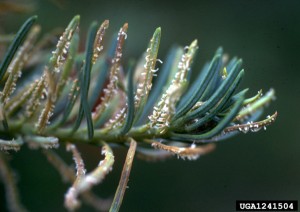Melampsorella caryophyllacearum

Oscar Dooling, USDA Forest Service, Bugwood.org
Description: The rust produces five types of spores of which two, spermatia and aeciospores, are produced on true fir; the others are produced on the alternate host. Infection of fir requires moist and temperate weather conditions and synchrony between spore (basidiospore) release and fir shoot development (1.). Aeciospores orange, globose, finely verrucose, 14-18 x 16-28 µm. Urediniospores yellow-orange, ellipsoid, sparsely echinulate, 12-18 x 16-30 µm. Telia on lower leaf surfaces, teliospores within lower epidermis, single-celled, cylindric, 13-20 µm wide (2.).
Identification: Bases of infected branches form an oval shaped to nearly spherical knob or gall. Damage from this rust species usually manifests as severely yellowed branches that have a marked absence of chlorophyl. The damage from this species is often confused with that of dwarf mistletoe.
Hosts: Infects many species within the genus Abies and requires secondary hosts to complete its lifecycle that are usually within the plant family Caryophyllaceae including chickweed sandwort and starwort.
Management: http://www.fs.usda.gov/Internet/FSE_DOCUMENTS/stelprdb5187433.pdf
Citations:
1. http://wiki.bugwood.org/HPIPM:Melampsorella_caryophyllacearum
2. http://forestry-dev.org/diseases/ctd/Group/Rust/rust9_e.html
Leave a Reply